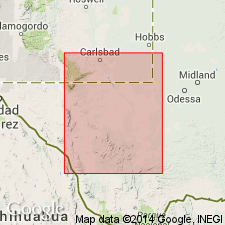
- Usage in publication:
-
- Leonard series
- Modifications:
-
- First used
- AAPG geologic province:
-
- Permian basin
Summary:
The authors advocate classification of American Permian as a system composed of 4 sedimentary divisions of series rank, based on section exposed adjacent to Delaware basin of west Texas and southeastern New Mexico in Permian basin. Divisions are (ascending): Wolfcamp, Leonard, Guadalupe, and Ochoa series [all first used as series terms]. Leonard series comprises beds formerly assigned to Leonard formation; term formation not used--raised to series rank. At type locality, south face of Glass Mountains (Brewster CO, TX), Leonard is more than 1,800 ft thick and consists of limestones and dark siliceous shales. Rests disconformably on Wolfcamp and underlies Word formation of lower Guadalupe age with seeming conformity. Characterized by brachiopods PRORICHTHOFENIA, SCACCHINELLA, and the diagnostic DICTYOCLOSTUS BASSI McKee; ammonoid PERRINITES; and the common fusulinids are primitive types of PARAFUSULINA. Leonard equivalents include Bone Spring formation of Sierra Diablo and Delaware and Guadalupe Mountains, Yeso and possibly San Andres formations of NM, and, in terms of older nomenclature, part of Wichita-Albany group plus all of Clear Fork group plus part of Double Mountain group in central TX. In OK and KS extends from horizon near top of Herington limestone to top of Dog Creek shale (i.e., base of Whitehorse group). In KS and NE units of Big Blue and Cimarron series should be reclassified. In OK term Minco should be dropped in favor of Leonard series.
Source: GNU records (USGS DDS-6; Denver GNULEX).
For more information, please contact Nancy Stamm, Geologic Names Committee Secretary.
Asterisk (*) indicates published by U.S. Geological Survey authors.
"No current usage" (†) implies that a name has been abandoned or has fallen into disuse. Former usage and, if known, replacement name given in parentheses ( ).
Slash (/) indicates name conflicts with nomenclatural guidelines (CSN, 1933; ACSN, 1961, 1970; NACSN, 1983, 2005, 2021). May be explained within brackets ([ ]).

